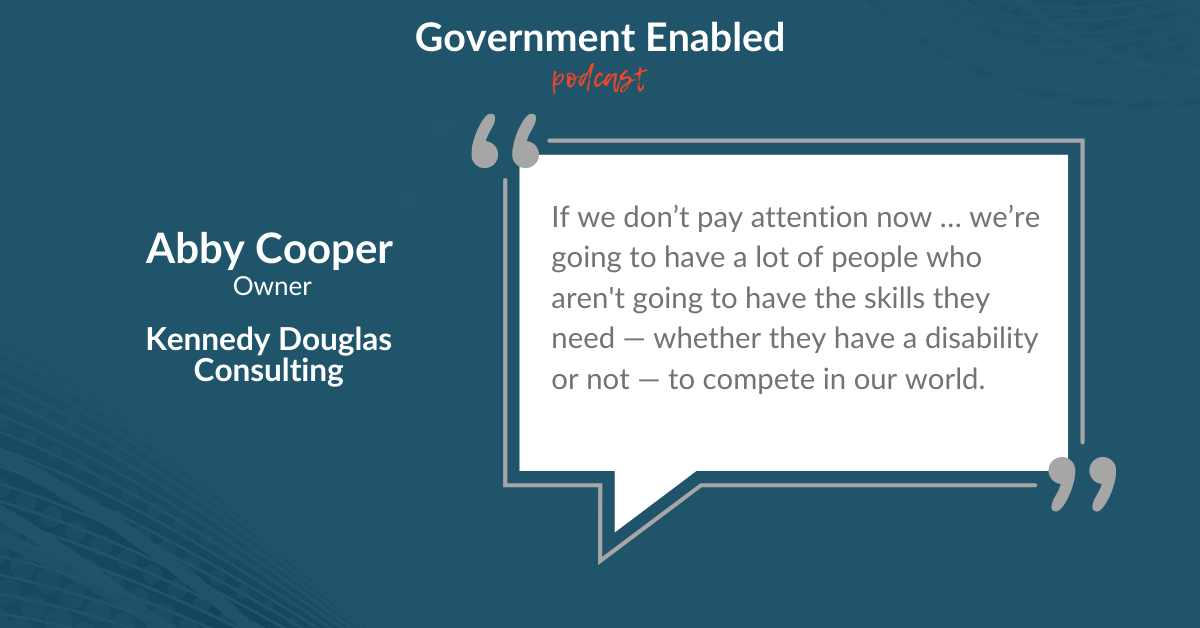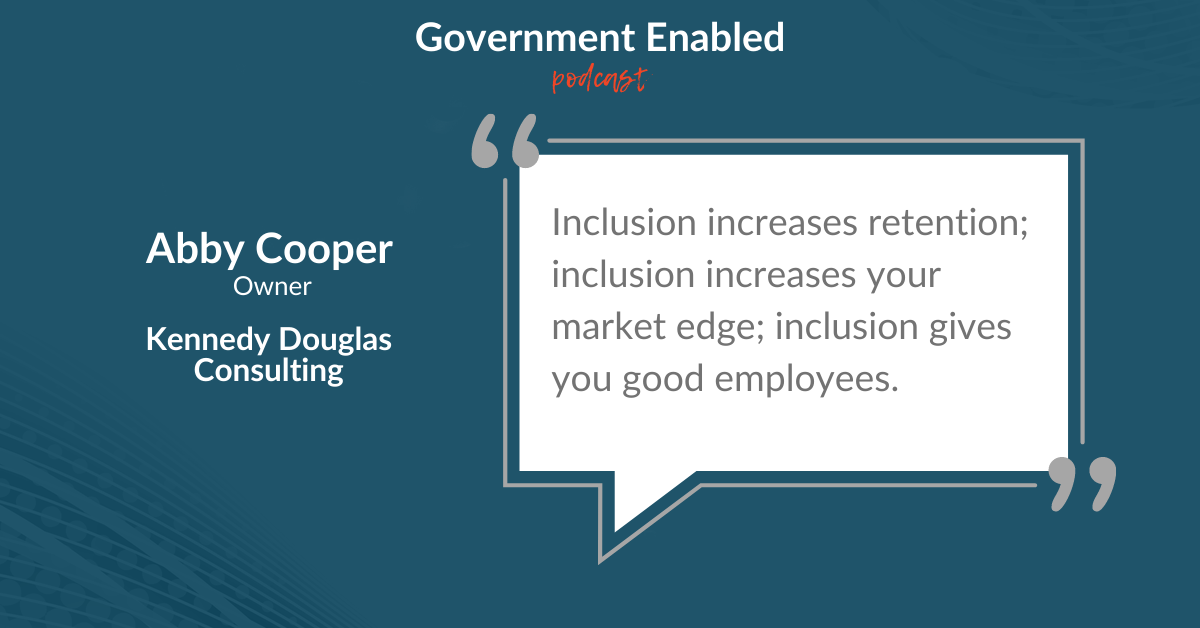Right now, one in four people living in the U.S. have a disability.
“Yet we have such problems employing people with disabilities,” says Abby Cooper, owner of Kennedy Douglas Consulting. She works with federal, state and local governments and nonprofits to increase employment opportunities for individuals with disabilities.
And too many people view disabilities as solely physical — disabilities you can see. That’s just not the case. “If you start realizing 70% of people who have disabilities have hidden disabilities, that’s an incredibly unfortunate way to think of things,” she says.
In a conversation on the Government Enabled podcast, Abby highlights common misconceptions and assumptions about disabled people, and she explains what it’ll take to get more individuals with disabilities employed.
How America is wronging people with disabilities
The fact is, state and local governments just aren’t doing enough to help individuals with disabilities enter the workforce. Why?
“The only thing I can figure out is it’s related to our biases and our assumptions,” Abby says. “I think a lot of times, people have incredible difficulty seeing the person — they just see the disability.”
She explains many people — intentional or not — reinforce these assumptions rather than take the time to truly understand and analyze the facts.
And that’s the big mistake many businesses make. They’re not testing or challenging their assumptions by tapping into this huge network of highly talented people.
Increasing employment in the disabled community
What can government agencies and businesses do to help increase employment in the disabled community? There are several actions the government — both at the local and state levels — can take to help increase employment among the disabled community.
Here’s what Abby suggests.
1. Increase funding
Perhaps the biggest issue is a lack of funding.
“There should be built-in incentives,” Abby explains. “I know that’s not popular in a time when everybody’s wringing their hands about how to survive, but I guarantee we’re not going to survive if we don’t find an innovative way to approach this.”
States should think about their fee and reimbursement schedules. Do promotions get reimbursed? Do high hourly wages get reimbursed? There’s a lot to think about here, but it’s essential governments figure this out, and funding is a must.
2. Introduce strategic plans with data-driven goals
In addition to a lack of funding, there’s also a lack of planning. Abby thinks more local and state governments should focus on setting goals. For example, maybe a state commits to increase employment among individuals with disabilities by 25% over the next five years.
But this leads to another roadblock: There’s a lack of comprehensive data available across states. The lack of data makes it difficult to truly analyze and identify major pain points that need to be addressed. With more data, it’ll be easier to set — and achieve — these goals.
3. Use consistent messaging across states
This may sound simple, but it’s essential: There needs to be a consistent message across states on this matter.
“Every person in the United States, if they want to work, they should have employment,” Abby says. “As a public official, it’s my responsibility to figure it out.”
Establishing a consistent message that proclaims the importance of employment for everyone can ensure the country is on the same page and can work together to find a solution.
4. Create a clear path for individuals with disabilities
When you have a disability, there’s not always one clear path you can take to become employed. It’s not necessarily as simple as graduating high school, going to college, then jumping into a career.
“In reality, this is something we need to look at,” Abby says. “Not only for folks with disabilities but for all members of a particular state — how do we help them move forward and advance and stay competitive and employed?”
This requires thinking about more training, apprenticeship and internship programs. For instance, Abby explains how Milwaukee established a pre-apprenticeship program where high schoolers could shadow local businesses. The idea is to introduce individuals to new skills they’ll need in order to obtain an apprenticeship. Plus, they get paid.
“If we don’t start putting some innovative projects in place now for people to get the technical skills they need, the critical thinking skills they need, then they’re going to be closed out of the market, and they’ll be isolated,” she says.
5. Consider the disabled community as a whole
You might be familiar with the Employment First State Leadership Mentoring Program (EFSLMP). This is a wonderful initiative that aims to provide employment for all individuals, particularly those with significant disabilities. However, this often excludes a large part of the disabled community.
“There’s a huge need to focus on folks with more significant disabilities, but there’s a whole population out there that’s not getting employed, who do not have a significant disability,” Abby says.
Again, this goes back to the fact that many individuals have hidden disabilities, and states need to focus on helping them enter the workforce, too.
6. Provide businesses with the tools for hiring
This responsibility doesn’t fall solely on the government. Businesses can also take steps to hire more employees with disabilities, but they might need to tap into government resources.
The first step is to help employers think about individuals with disabilities differently.
“If you’ve gone through our world for your entire life with a disability, you have to be a great problem-solver because there are so many issues that confront you, and you’ve got to figure out,” Abby says. “So you’ve got great, innovative people not being utilized.”
One way the government can help is to continue to offer additional training on disability law, etiquette and accessibility.
“You have businesses that are nervous about employing people with disabilities,” Abby says. “Frequently, they’re nervous because they don’t understand the ADA, or they’re nervous because coworkers won’t like it because they’re not sure how to act.”
It’s important state governments continue to provide these resources through the Division of Rehabilitation Services (DVRS).
FedHR Navigator
A fully configurable Federal HR solution that meets your agency’s unique Human Resources requirements.


